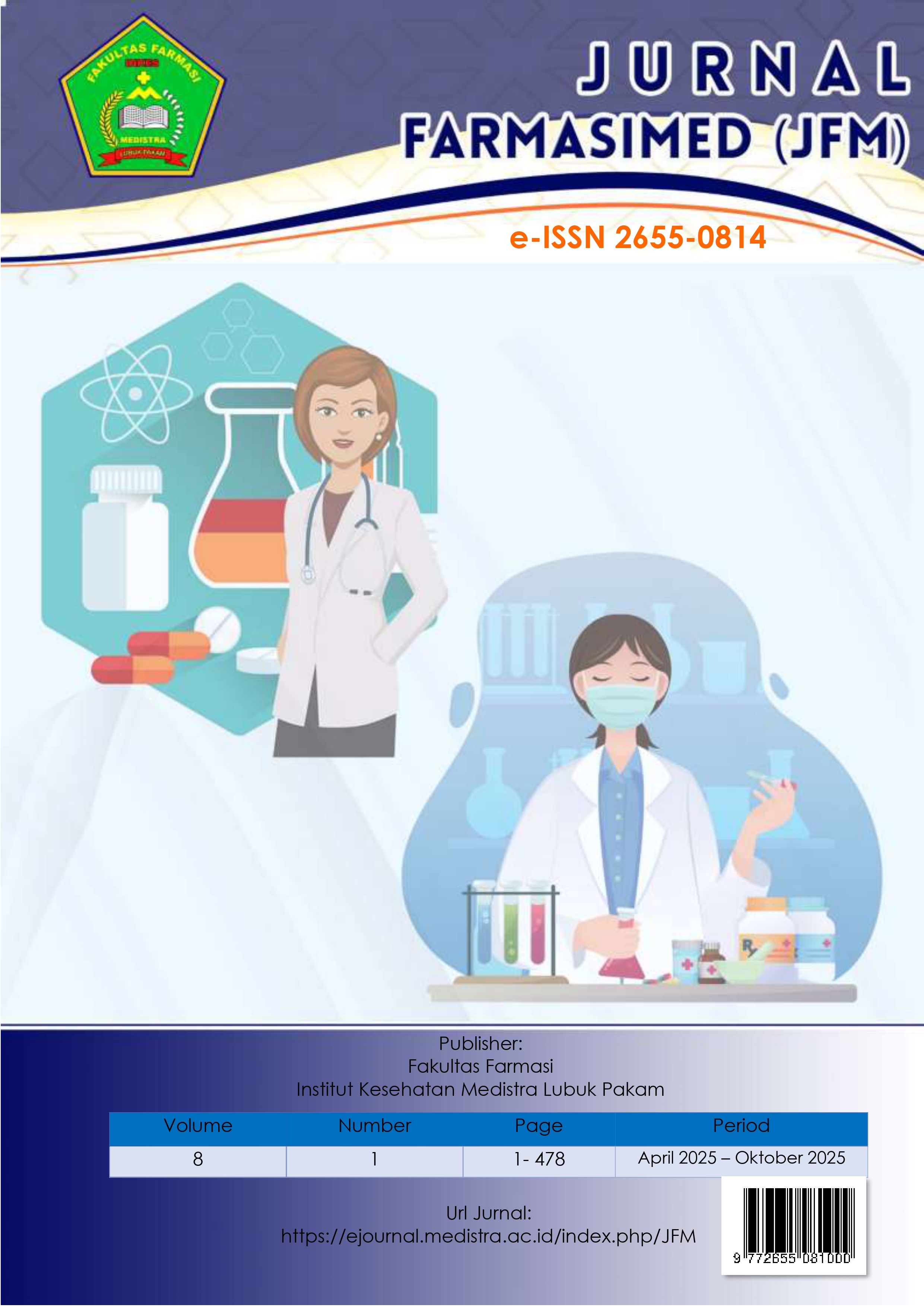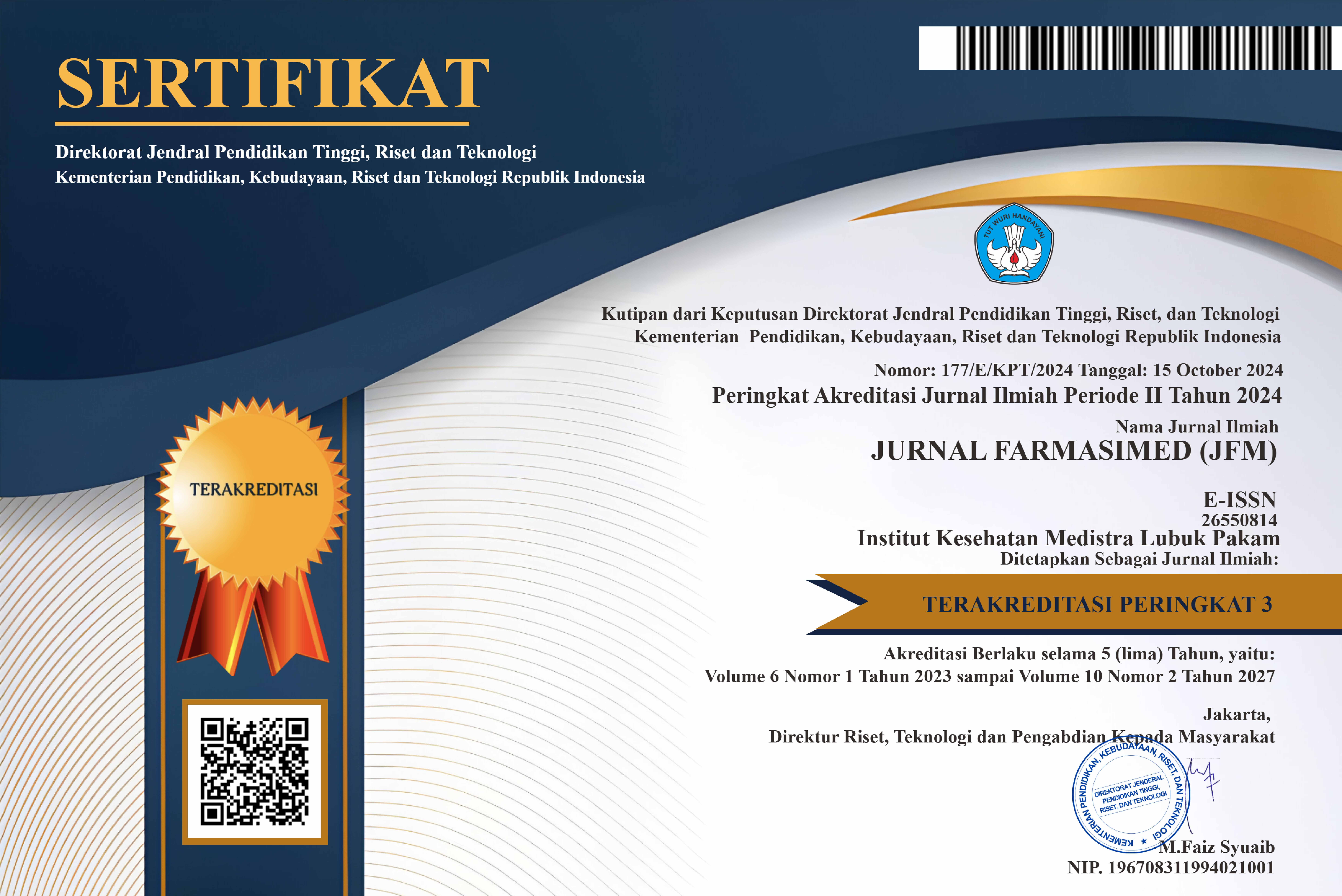Evaluation of Antidiabetic Potential (α-Glucosidase and α-Amylase Enzyme Inhibition Assay) of Mundu Leaf Extract [Garcinia dulcis (Roxb.) Kurz]
DOI:
https://doi.org/10.35451/nex3ag44Keywords:
α-Glucosidase, α-Amylase Enzyme, Antidiabetic, Mundu Leaf ExtractAbstract
Diabetes Mellitus (DM) is a chronic disease that requires appropriate solutions for its management. To date, synthetic antidiabetic drugs frequently cause side effects in the body. The search for natural antidiabetic agents has therefore been carried out by exploring the potential of mundu leaves, which are considered safer as they originate from natural sources. Mundu leaves contain flavonoids, phenols, and tannins, which may act as natural antidiabetic agents due to their richness in hydroxyl and aromatic compounds. Antioxidant compounds play a role in protecting body cells from oxidative stress, which is strongly associated with diabetes. Several species from the Garcinia genus have been studied, but to date, no research has focused on the antidiabetic potential of mundu leaves. Through assays of mundu leaf extract in inhibiting α-amylase and α-glucosidase enzymes, as well as antioxidant tests, DM could potentially be better controlled, providing a reference for its use as a natural antidiabetic and antioxidant agent. Mundu leaves were prepared and macerated using ethanol as a solvent, followed by evaporation with a rotary evaporator. Phytochemical screening was conducted to detect the presence of active compounds. The inhibitory activity of mundu leaf extract against α-glucosidase and α-amylase enzymes was measured using a UV-Visible spectrophotometer to obtain absorbance values. The absorbance data were then used to determine the percentage of inhibition, allowing the calculation of IC50 values as a benchmark for antidiabetic activity. The results demonstrated that the mundu leaf extract exhibited antidiabetic properties, with IC50 values of 51.058 ppm and 33.004 ppm, categorized as strong and very strong, respectively.
Downloads
References
[1] American Diabetes Association Professional Practice Committee, “2. Classification and Diagnosis of Diabetes: Standards of Medical Care in Diabetes—2022,” Diabetes Care, vol. 45, no. Supplement_1, pp. S17–S38, Jan. 2022, doi: 10.2337/dc22-S002.
[2] Y. Zheng, S. H. Ley, and F. B. Hu, “Global aetiology and epidemiology of type 2 diabetes mellitus and its complications,” Nat Rev Endocrinol, vol. 14, no. 2, pp. 88–98, Feb. 2018, doi: 10.1038/nrendo.2017.151.
[3] S.-K. dr. Soebagijo Adi Soelistijo et al., Pedoman pengelolaan dan pencegahan diabetes melitus tipe 2 di indonesia 2021, 1st ed. PB Perkeni, 2021.
[4] P. Saeedi et al., “Global and regional diabetes prevalence estimates for 2019 and projections for 2030 and 2045: Results from the International Diabetes Federation Diabetes Atlas, 9th edition,” Diabetes Res Clin Pract, vol. 157, p. 107843, Nov. 2019, doi: 10.1016/j.diabres.2019.107843.
[5] H. Sun et al., “IDF Diabetes Atlas: Global, regional and country-level diabetes prevalence estimates for 2021 and projections for 2045,” Diabetes Res Clin Pract, vol. 183, p. 109119, Jan. 2022, doi: 10.1016/j.diabres.2021.109119.
[6] N. Wangkiri, T. Sarnsri, T. Thongkanjana, and S. Sae-tan, “Genetic diversity of ‘Bangle’ (Zingiber montanum (J.Koenig) Link ex A.Dietr.) inferred from sequence-related amplified polymorphism markers,” Agriculture and Natural Resources, 2021, doi: 10.34044/j.anres.2021.55.1.14.
[7] P. Thepthong and T. Lookpan, “Total Phenolic Content, Antioxidant and Antityrosinase Activities of Garcinia dulcis Root Extract,” ASEAN Journal of Scientific and Technological Reports, vol. 24, no. 1, pp. 94–104, Apr. 2021, doi: 10.55164/ajstr.v24i1.241028.
[8] M. Nethengwe, N. Kerebba, K. Okaiyeto, C. S. Opuwari, and O. O. Oguntibeju, “Antioxidant, Anti-Diabetic, and Anti-Inflammation Activity of Garcinia livingstonei Aqueous Leaf Extract: A Preliminary Study,” Int J Mol Sci, vol. 25, no. 6, p. 3184, Mar. 2024, doi: 10.3390/ijms25063184.
[9] Md. Z. Amin, M. Afrin, N. S. Meghla, Md. A. Nur, Md. M. Rahman, and M. J. Uddin, “Assessment of antibacterial, anti-inflammatory, and cytotoxic effects of different extracts of Gynura procumbens leaf,” Current Therapeutic Research, vol. 95, p. 100636, 2021, doi: 10.1016/j.curtheres.2021.100636.
[10] J. Prakulanon, S. Duangsrisai, S. Vajrodaya, and T. Thongchin, “Evaluation of phytochemical profile, and antioxidant, antidiabetic activities of indigenous Thai fruits,” PeerJ, vol. 12, p. e17681, Jul. 2024, doi: 10.7717/peerj.17681.
[11] J. Wairata, E. R. Sukandar, A. Fadlan, A. S. Purnomo, M. Taher, and T. Ersam, “Evaluation of the Antioxidant, Antidiabetic, and Antiplasmodial Activities of Xanthones Isolated from Garcinia forbesii and Their In Silico Studies,” Biomedicines, vol. 9, no. 10, p. 1380, Oct. 2021, doi: 10.3390/biomedicines9101380.
Downloads
Published
Issue
Section
License
Copyright (c) 2025 Novandi Purba, Nur Ulina M. Br Turnip, Jhon Patar Sinurat

This work is licensed under a Creative Commons Attribution-NoDerivatives 4.0 International License.
Copyright in each article is the property of the Author.

























